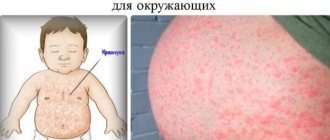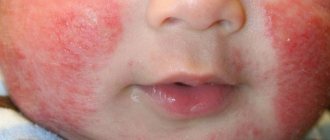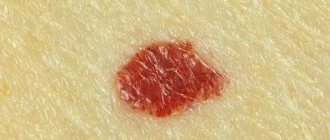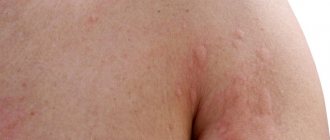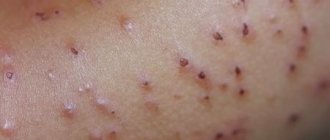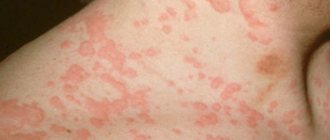Rubella is a viral infectious disease. The disease is transmitted by airborne droplets.
There are several forms in which rubella occurs in children under one year of age, the symptoms of each of them can manifest themselves differently. Read more about the signs of rubella in infants later in the material.
Key Facts
Rubella is considered to be a childhood disease. Over 80% of registered cases are in children under 4 years of age. If adults get sick, the peak occurs in the age group of 21-30 years. The main contingent of patients are women. From this thematic collection of photos you will learn all the most important things about rubella in adults - about symptoms, treatment, prevention, risks, everything a potential patient of a doctor needs to know.
Rubella in adults
Rubella, or German measles (measles rubella) is a disease of viral etiology, accompanied by enlarged lymph nodes (cervical, occipital) and the appearance of a maculopapular rash. In most cases, rubella occurs with an increase in body temperature, which is short-term in nature. In adults, the disease often develops more severely than in children.
The causative agent is an RNA virus of the Rubivirus genus;
The rubella virus can remain active for a long time at low ambient temperatures, and is also resistant to elevated ones. Due to its great vitality, it easily spreads from person to person in any season of the year.
After a single infection and recovery, the body develops a persistent immune response, so it is impossible to become infected with rubella again.
Photo
Epidemiology
General incidence statistics are approximately 452 people per 100 thousand population.
Due to the high contagiousness of the virus, all ages are susceptible to the disease, but rubella occurs much more often in children than in adults. In the age group of 21-30 years, the disease is more common, especially among women. Children under one year old and older people get sick relatively rarely.
Causes of the disease
The source of human infection is a patient with rubella, both during the acute phase and in the prodromal period (2-3 days). If a child has a congenital disease, it is dangerous to others until 1 year from birth.
The route of infection is airborne; when congenital rubella appears, it is through the placenta.
After the virus penetrates the mucous membranes of the mouth and nose, its particles are localized in the back of the pharynx, in the cervical and occipital lymph nodes, and within a week they spread through the bloodstream throughout the body. Almost immediately, the immune system begins to produce antibodies to the virus.
Recent studies prove that the virus is able to be released from the nasopharynx of an infected person even after the disappearance of the main symptoms of the disease, for at least 3 days. The duration of the prodromal period can be up to 9 days, during which a person is potentially dangerous to others. The concept of the routes of transmission of the rubella virus also requires revision: its detection in the urine and feces of patients suggests other ways of penetration into the body of a healthy person besides airborne droplets.
Kinds
In adults, rubella occurs only when infected from a sick person, and is therefore considered acquired. Among children, there are frequent cases of congenital rubella, a disease transmitted through the placenta during fetal development. As a rule, this type of rubella is very severe, leading to heart defects, abnormalities in the development of hearing and vision, and developmental delays in the child.
Depending on the symptom complex that manifests itself in rubella, the disease is classified into the following types:
- ordinary (typical) rubella;
- atypical rubella.
Atypical types of the disease may imply a milder course (without a characteristic rash, often with the absence of fever), erased or asymptomatic rubella, as well as a disease accompanied exclusively by lymphadenopathy or local rashes of a small area. Atypical types of rubella can lead to massive infection of others due to the patient’s failure to comply with precautions.
The severity of the disease is differentiated:
- Mild form (there are no symptoms of intoxication, the temperature is subfebrile or normal, the rash is barely noticeable and does not cause severe discomfort).
- Moderate form (the patient is bothered by headaches, body temperature can reach 38 degrees, there are signs of intoxication of the body, the rash is severe).
- Severe form (high body temperature, severe itching, nausea, diarrhea).
Depending on the consequences, the disease can be:
- uncomplicated;
- with accompanying complications (addition of a secondary infection or exacerbation of existing diseases).
Symptoms and signs of rubella
The incubation period for rubella is 11-25 days, most often 15-18 days. In children, there are usually no warning signs of the disease, with the result that the first sign is a rash on the body.
The prodromal period is characteristic of the development of the disease in adults.
Within 3 days the following symptoms are observed:
- lack of appetite;
- headache;
- fever or low-grade fever;
- myalgia;
- runny nose, cough, sore throat;
- lacrimation, redness and irritation of the conjunctiva;
- dizziness, photophobia;
- pain and enlargement of the lymph nodes.
Next, a small rash of pink, red, spotted or papular (in the form of nodules) appears on the patient’s body, almost not rising above the surface. At the initial stage, the exanthema spreads only to the face, scalp and body, covering all areas of the body (limbs, buttocks, extensor surfaces of joints) within 24 hours. The skin around individual elements of the rash does not change its appearance; A specific sign of rubella is the absence of skin symptoms on the palms and soles of the feet.
Severe rubella in adults can lead to fusion of rashes. In this case, large areas of hyperemic skin (erythematous fields) form on the patient’s body.
As a rule, the rash is accompanied by mild or severe itching. Atypical forms of rubella can appear as spots localized on the mucous membranes of the oropharynx (on the palate, inside the cheeks).
Body temperature during the acute period may remain normal, but more often it rises daily in the afternoon or evening.
The cervical and occipital lymph nodes are hardened, painful and can be palpated not only during the rash phase, but also within a month after clinical recovery. After 3-5 days, the rash disappears without a trace, leaving no skin signs (peeling, scars).
Additional symptoms of rubella in adults:
- joint pain;
- muscle pain;
- an increase in the size of the spleen and liver;
- cough, rhinitis.
Consequences and complications of the disease
Severe rubella can be accompanied by signs of severe intoxication, and also cause a number of complications from the nervous system or brain. In some cases, the penetration of the virus into the body provokes the development of rubella panencephalitis - a disease that can develop in children with a congenital form of rubella in the second decade of life, but in rare cases it also occurs in adults.
Complications from rubella can also be expressed in the form of cerebral edema, meningitis, epileptic seizures, convulsions, and decreased intelligence.
The prevalence of such consequences is quite low; However, if the course of the disease is aggravated, it is worth seeking medical help in a timely manner.
Rubella and pregnancy
Rubella is most dangerous when a pregnant woman is initially infected.
If infection occurs in the first trimester, most often the embryo quickly dies, resulting in spontaneous abortion. If the fetus continues to develop, it develops chronic intrauterine rubella, accompanied by damage to the skeleton and internal organs. The most common developmental anomalies are hydrocephalus, deafness, heart defects, hepatitis, blindness, multiple disorders of the structure and functioning of the body and organs (gross deformities).
Infection of a pregnant woman after 16 weeks practically does not threaten the life of the fetus. In some cases, a child is born with single mild developmental defects, low-grade inflammatory processes, and blood disorders, which are usually reversible. Infection in the last weeks before birth can lead to the appearance of a congenital form of rubella in the child.
Diagnostics
Diagnosis is based on clinical signs of rubella; In addition, the doctor determines the possibility of contact with the patient. The diagnosis can be clarified by a blood test using PCR and ELISA for the presence of antibodies to the virus, which are formed from the onset of the disease. Viral DNA is also isolated by inoculating material taken from the nasopharynx of an infected person.
Rubella is differentiated from measles, drug allergies, manifestations of some enteroviral infections, syphilis, and scarlet fever.
Treatment of rubella in adults
No specific therapy for rubella has been developed; the disease does not require treatment, so medications are selected taking into account the general symptoms that appear during the course of the infection:
- Drink plenty of fluids.
- Bed rest in the acute phase of the disease.
- Isolation of a person during a period of illness.
- If body temperature rises, use antipyretics (paracetamol, Nurofen, analgin, amidopyrine, Coldrex, indomethacin).
- In severe cases, antiviral drugs are used (arbidol, isoprinosine, amizon).
- Immunocorrectors (anaferon, interferon, cycloferon, viferon).
- For dry cough - sinekod, codelac.
- For wet cough - erespal, mucolytics.
- For a runny nose, use nasal drops with a vasoconstrictor effect (xylene, xymelin).
- Vitamin C, ascorutin for the purpose of general strengthening of the body.
- For pain in muscles and joints - antihistamines (suprastin, pipolfen), as well as NSAIDs.
- For conjunctivitis, instill albucid into the eyes.
- With prolonged enlargement of the lymph nodes, UHF is prescribed to the area of the back of the head and back of the neck.
The prognosis in most cases of rubella is favorable, except for infection of pregnant women before the 16th week of pregnancy, when artificial termination of pregnancy is indicated. If the patient's nervous system is damaged, urgent hospitalization is indicated.
Rubella vaccine
Vaccination against rubella can be carried out in childhood and adulthood. There are complex vaccines (measles, mumps, rubella), as well as monovaccines, which are administered twice. The immunity formed after vaccination lasts for 10 years, and often remains for life. Children are vaccinated against the rubella virus at the age of 6 years; If immunization has not been carried out, the vaccine can be administered at any time before the age of 18, provided there is no history of episodes of rubella. Women who have not had rubella should be vaccinated 6 months before. before planned conception.
Treatment with folk remedies
For rubella in adults, it will be useful to use herbal medicine to increase the body's resistance to the virus as a source of vitamins and other useful substances:
- Mix lingonberries and rose hips (1 spoon each), pour 500 ml. boiling water, leave. Take daily.
- Prepare an infusion of St. John's wort (1 spoon per glass of water), add a spoonful of mashed black currant berries into the hot mixture. Drink after 30 minutes.
- Drink 100 ml daily. infusions of yarrow, linden blossom, nettle, coltsfoot, currant leaves, raspberries.
Lifestyle and proper nutrition
In severe cases of the disease in adults, nutrition is indicated according to diet No. 13, the purpose of which is a gentle regime and the removal of toxins in infectious diseases. The menu includes dishes with reduced calorie content by limiting fats and carbohydrates. The proportion of fortified foods in the diet should be increased. It is recommended to eat 6 times/day; The consistency of food is predominantly puree-like or liquid.
Excluded from the diet:
- any spicy food;
- fatty soups, meat;
- baking;
- smoked meats;
- fried food;
- fatty dairy products;
- vegetables that provoke increased gas formation; - alcohol, coffee.
Disease prevention
Isolation of patients in the acute period of rubella is ineffective, since the contagiousness of the virus is high even before the onset of clinical signs. However, if episodes of rubella occur in kindergartens, a week-long quarantine may be introduced.
It is extremely important to separate pregnant women from rubella patients, both adults and children. An emergency preventive measure after suspected contact with an infected person is the administration of anti-rubella gamma globulin to the pregnant woman.
Where does rubella come from?
The probability of becoming infected, even through fleeting contact with an infected person, in a person without specific immunity is close to 100%. To become a model for a photo with signs of rubella in adults, a fleeting presence within a radius of 10 meters from the infected person is enough.
Rubella during pregnancy
Despite the fact that rubella is easy in children, getting it during pregnancy is extremely dangerous.
Read here! Hyperthyroidism - description of effective treatment and useful information on how to cure the thyroid gland (135 photos)
In the first weeks of pregnancy, the child develops all the basic systems. The rubella virus that enters the body during this period can lead to miscarriage or the need to terminate the pregnancy for medical reasons.
If a woman has been vaccinated against rubella, there is a chance that the child will be healthy.
Symptom complex as the disease progresses
The infected person's face is covered with dust, the submandibular and then other groups of lymph nodes enlarge.
On the second day after the virus clearly manifests itself, the rashes cover the entire body. You will never see a rash on the palms and soles of the hands and feet in photographs of adults with true rubella - this fact plays a vital role in diagnosing the disease. IT IS IMPORTANT TO KNOW!
Rubella vaccine
The only and surest way to avoid complications or complex course of the disease is vaccination against rubella. The vaccine is administered twice. The first time - at a year or a year and a half, the second time - at 6 years. If the child has not received the vaccine during this period, it can be done at any age.
It is advisable for girls to be vaccinated before planning pregnancy.
The vaccine may cause minor side effects, such as fever, minor rash, and swollen lymph nodes.
All these symptoms disappear in 5-7 days, and immunity from this virus remains for 10-20 years and the likelihood of infection is significantly reduced.
Risks for pregnant women
The rubella virus is especially dangerous for the fetus if its activity is shown in photographs of pregnant women in the early stages. The disease often provokes spontaneous abortion, and if not, it causes severe pathologies in the born child. More information about rubella for pregnant women in the early stages is described in thematic videos.
Types of rubella and their characteristic manifestations
There is no generally accepted classification of rubella, but doctors distinguish the following clinical forms of the disease:
- acquired: typical, atypical (without rash), inapparent (subclinical);
- congenital.
Typical acquired rubella is mild in most episodes and is not accompanied by a significant deterioration in health. In 48% of children, body temperature rises to subfebrile, in 30% it fluctuates between +38...39°C, in the rest it remains normal.
In almost all patients, fever persists for 2-4 days.
Acquired form
Typical signs of the disease are moderate lymphadenopathy and catarrhal inflammation of the upper respiratory tract. The serological method, i.e., an enzyme-linked immunosorbent test, helps to recognize the atypical and subclinical forms.
Congenital form
It is observed in children whose mothers were ill during pregnancy.
It is accompanied by eye damage (cataracts, microphthalmia, corneal opacities), heart defects (pulmonary stenosis, ventricular septal defects), deafness, mental retardation, microcephaly. Additional manifestations include intrauterine growth retardation, bone lesions in the metaphyseal region, enlarged spleen and liver, thrombocytopenic purpura, myocardial necrosis, interstitial pneumonia, and myocarditis.
Some children show signs of cellular and humoral immunodeficiency. This type of disease can develop even after the mother has had asymptomatic (inapparent) rubella.
How to distinguish from measles, scarlet fever and other diseases?
Rubella is a disease accompanied by enlarged lymph nodes, the appearance of a small pink rash and cold-like symptoms.
There are other diseases with similar symptoms:
- measles _ Accompanied by the appearance of multiple spots (small and convex), localized behind the ears, on the face, elbows and knees. The rash is accompanied by itching and merges into huge red spots. Associated symptoms include conjunctivitis, runny nose, and suffocating cough. Lymph nodes do not enlarge, temperature can rise to +40°C and above;
- scarlet fever . Always accompanied by a sore throat (a characteristic symptom of the disease is bright crimson tonsils). The rash appears immediately in the form of small, barely noticeable pink dots on the face and body. The spots are more intense in the skin folds, on the sides and lower abdomen. Vomiting is sometimes observed;
- chicken pox . It is characterized by the appearance of pink spots, crusts, and bubbles with colorless liquid. A distinctive feature of the disease is that it affects the mucous membranes. With chickenpox, only the cervical lymph nodes become enlarged, there is no cough or runny nose;
- allergy _ It is characterized by the appearance of a rash in the form of itchy, flaky spots or pimples. Lymph nodes do not enlarge with allergies, and the temperature does not rise.
Diagnostics
To confirm the diagnosis of rubella, additional research methods are used:
- General clinical blood tests (leukopenia, lymphocytosis, normal ESR) and urine.
- Isolation of the virus from biological materials (nasopharyngeal swabs, blood, feces, urine).
- Special serological tests determine the state of the immune system and its changes throughout the disease. Antibodies to rubella virus are most often determined using RTGA. The examination for this purpose is taken from the patient’s vein twice - at the beginning of the disease on days 1-3 and again after 7-9 days. Rubella is indicated by an increase in antibody titer by more than 4 times in the second analysis compared to the first. Infection is indicated by the presence of IgM antibodies in the ELISA. If immunoglobulin G is present, this indicates a previous illness.
Conclusion
Rubella is harmless to children, is more difficult for adults and poses a danger to pregnant women.
To avoid infection and unpleasant consequences, it is worth getting vaccinated in a timely manner, following the recommendations of doctors and closely monitoring the slightest manifestations of the disease, such as a minor rash and headache.
Variants of the course of rubella
The course of rubella is typical (its characteristics are described above). Many parents know what rubella looks like. But you need to take into account the presence of atypical forms, which come in two varieties:
- Erased - in this case, the clinical manifestations are mild, weakly expressed in the form of a reaction of the lymph nodes, a slight, not profuse rash, and low-grade fever.
- Asymptomatic - in this case there are no clinical or hematological abnormalities. This variant can mainly be detected in rubella foci using a serological diagnostic method.
Features of the course of the disease in children of the first year of life
In children of the first year of life, rubella infection occurs extremely rarely. During intrauterine development, the fetus receives antibodies to various infectious diseases that the mother had. They last for some time after birth.
But sometimes it happens that a woman did not have rubella before pregnancy. Therefore, her child in this case has no immunity against this virus. If infected at this age, the disease is characterized by a lightning-fast course, and the baby’s condition is serious. Since the blood-brain barrier is not mature until 1 year of age, there is a high risk of encephalitis and meningitis. When infected with rubella, all children of this age are hospitalized as an emergency.
